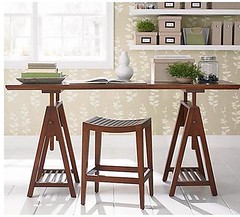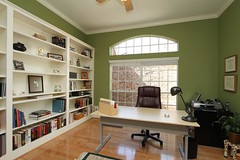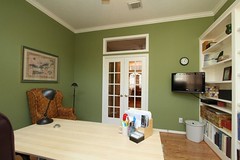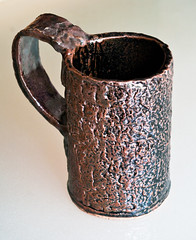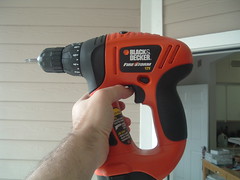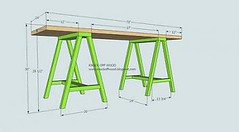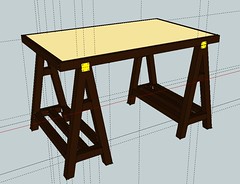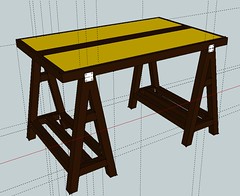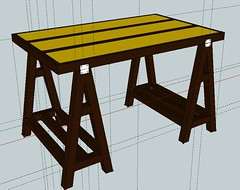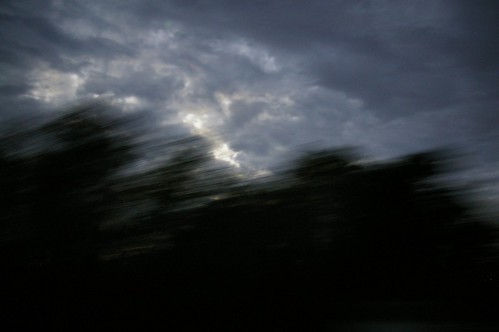The unaffordable initial inspiration
We're slowly winding down from our home purchase (we may even move in one of these days...) and all its ancillary purchases (new furniture, power tools, yard equipment, etc...). To say that our bank account has seen a lot of action is putting it mildlyi. Even in the financially exhausted state I find myself in, there are still a few things we need, including new desks for our study.
Our new study, picturing the previous owner's furniture
While out shopping for other furniture, I found a desk I liked, but the price tag was far more than I was comfortable with. In fact, after months of hemoragghing money, with hands in my pocket at every turn, dealing with amounts of money that are far beyond my comfort range, it was the final straw. I looked at the desk, looked at my hands, looked back at the desk, and said..
“I can build this...ii”.
I've never really shied away from doing something myself rather than spend money on it. It's an ethic I'm pretty drastically in favor of in general. What you create will always be more satisfying than what you consume. I know it's become the trendy thing in some circles, but regardless, I still think the recent boom of back-to-the-earth, handcraftsy, brew-your-own, revival of traditional skills is pretty damn cooliii. I never had a very solid grounding in practical skills. My grandfathers were able craftsmen, but I think around my Dad's generation, those skills started to dwindle for suburbanites. By the time I came around, the shift from working without your hands to working with circuitsiv was already in full swing. So what I have is either largely, and poorly, self-taught, , some dim and angsty memories of high school shop class terror, or a result of the fantastic reawakening enabled by the internetv But in the new house I have a small shop area in the garage, and I have been inspired by some of my more serious DIY friends, so I am feeling ancestral urges to make things with my hands.
Previous oddities – Pottery Failure, wine cork board failure, Firestorm! - the sum of my current toolset.
My previous, limitedvi projects have had mixed results. My current desk is a solid affair, made completely from unfinished pine lumber straight from Lowe's. To my credit, it's lasted 9 years now, and is going strongvii. However, it's based primarily on the Apocalypse Now school of technique:
(Willard: They told me that you had gone totally insane, and that your methods were unsound.
Kurtz: Are my methods unsound?
Willard: I don't see any method at all, sir.)
You get the picture. This desk is designed only to keep things off the floor. When you look up utilitarian in the dictionary....well, it gives a definition for utilitarian, but it would be REALLY applicable to this desk. It's so unassuming I didn't even take a picture of it to post anywhere.
My next furniture based outing was a guitar stand for my guitars. Like the desk, this is pretty utilitarian, but in an effort to grow, I tried to make it a bit more aesthetically..well, “pleasing” would be reaching, let's go with “acceptable”. Despite epic staining failure, it actually turned out nicely enough. Sadly, these two adventures gave me probably more confidence than I deserve.
Mutliple Guitar Stand, or, “how not to stain”.
Which takes us back to the present. I need a desk. After measuring our space, and looking around online, I had a basic idea of what I wanted to do. The rational approach would be to find some plans, follow them to the letter, and finish the project sometime before the sun goes nova. Too easy. Enter Google Sketchup. I had back-of-the-napkin'd a general design, based on a couple trestle desks I had seen. Sketchup fueled my unfortunately creative urges by allowing things to get..complicated. What went from a simple pine lumber affair is now gussified up to include exotic hardwoods, complicated latching mechanisms, and pocket-hole joinery techniques I do not understand but will be mercilessly applying to the piece.
Evolution of a design, from someone's else's idea, to my final plan(s)
So now I'm at the cusp of starting the project. I've picked out potential woods (curly hard maple as a reminder of home, walnut trim for contrast), picked out new power tools (orbital sander, Kreg jig and compound miter saw), and found local places to secure it all. I still need to decide what the final layout of the top will be...one solid maple top, or alternating broad maple and narrow walnut strips. But I'm pretty excited, with a completely unfounded confidence. And I think it will turn out well, regardless....I will have a solid wood deskviii, and the tools to make it and other things, for far less than buying the new desk. And I think mine will be generally cooler, and will certainly have more satisfaction attached to it. I may tell grandkids about how I made that desk...I can't imagine regaling them with a tale of going out any buying it at pottery barn. Now the fun begins.
----------------------------------------------------------------------------
Notes
iThe two words that best describe my debit card are “en fuego”.
ii And, in my head, “..I can make it better...faster...stronger....we have the technology...”
iiiEven if some of the participants are doing it ironically while drinking PBR. Ironically.
ivI can build you a new computer in nothing flat. However, making a birdfeeder completely stumped me.
vIt never fails to amaze me that a virtual medium has largely resurrected what is more akin to an oral tradition...informal knowledge diffused and passed directly from people to people.
viLimited by skill first and foremost, but also by limited space and a set of tools that includes : 1) hammer, 2) cheap cordless drill/jig saw combo unit.
viiThough, let's be honest, when something is made of 2X4's and has even a rudimentay support system, it's not exactly a fragile flower.
viiiThere is absolutely nothing these days that isn't veneers over generic hardwoods. Even in the pricey places. The only true solid hardwood without veneer I found was in an Amish place, and the price reflected it.

